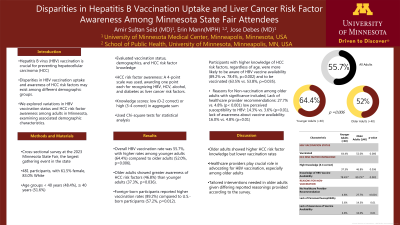Tuesday Poster Session
Category: Liver
P4588 - Disparities in Hepatitis B Vaccination Uptake and Liver Cancer Risk Factor Awareness Among Minnesota State Fair Attendees
Tuesday, October 29, 2024
10:30 AM - 4:00 PM ET
Location: Exhibit Hall E

Has Audio

Amir Sultan Seid, MD
University of Minnesota
Minneapolis, MN
Presenting Author(s)
Amir Sultan Seid, MD1, Erin Mann, MPH2, Jose Debes, MD, PhD1
1University of Minnesota, Minneapolis, MN; 2University of Minnesota School of Public Health, Minneapolis, MN
Introduction: Vaccination against hepatitis B virus (HBV) is for prevention of hepatocellular carcinoma (HCC). This study sought to explore the variations in HBV vaccination status and uptake among adults in Minnesota, as well as to determine the associated demographic characteristics and awareness of HCC risk factors.
Methods: A structured cross-sectional survey was conducted among 481 adult participants (61.5% female, 83.0% White) at the 2023 Minnesota State Fair, the largest event in the state attracting visitors from diverse backgrounds and age groups. Participants were categorized into younger (age < 40, 48.4%) and older (age ≥40, 51.6%) adult groups. The survey evaluated vaccination status, demographic factors, and knowledge of HCC risk factors. Knowledge scores were categorized as low (0-2 correct) or high (3-4 correct). Chi-square tests were utilized to assess the differences in vaccination status and uptake between age groups and relationships with demographics and HCC knowledge.
Results: Among the surveyed individuals, 55.7% reported being vaccinated against HBV, while 44.3% were unvaccinated or unsure. Vaccination rates were significantly higher among younger adults compared to older adults (64.4% vs. 52.0%, p=0.006). Conversely, older adults exhibited significantly greater awareness of HCC risk factors (46.8% vs. 37.3%, p=0.036). Participants born in the U.S. had lower reported vaccination rates compared to foreign-born participants (57.2% vs. 89.2%, p=0.012). Participants with higher knowledge of HCC risk factors were more likely to know about the availability of an HBV vaccine (89.2% vs. 78.4%, p=0.002) and more likely to be vaccinated (63.5% vs. 53.8%, p=0.035). No differences in knowledge of risk factor rates were found based on gender, race, or metropolitan status. Primary reasons for non-vaccination among older adults (compared to younger adults) included the absence of recommendations from healthcare providers (27.7% vs. 4.8%, p< 0.001), a lack of perceived susceptibility to HBV (14.3% vs. 3.6%, p=0.01), and a lack of awareness regarding vaccine availability (16.0% vs. 4.8%, p=0.01).
Discussion: Although older adults demonstrated higher levels of knowledge, their vaccination rates were lower, underscoring the necessity for targeted interventions. Healthcare providers have a crucial role in advocating for HBV vaccination, particularly among older adults, as the absence of provider recommendations was recognized as a major factor contributing to non-vaccination.
Disclosures:
Amir Sultan Seid, MD1, Erin Mann, MPH2, Jose Debes, MD, PhD1. P4588 - Disparities in Hepatitis B Vaccination Uptake and Liver Cancer Risk Factor Awareness Among Minnesota State Fair Attendees, ACG 2024 Annual Scientific Meeting Abstracts. Philadelphia, PA: American College of Gastroenterology.
1University of Minnesota, Minneapolis, MN; 2University of Minnesota School of Public Health, Minneapolis, MN
Introduction: Vaccination against hepatitis B virus (HBV) is for prevention of hepatocellular carcinoma (HCC). This study sought to explore the variations in HBV vaccination status and uptake among adults in Minnesota, as well as to determine the associated demographic characteristics and awareness of HCC risk factors.
Methods: A structured cross-sectional survey was conducted among 481 adult participants (61.5% female, 83.0% White) at the 2023 Minnesota State Fair, the largest event in the state attracting visitors from diverse backgrounds and age groups. Participants were categorized into younger (age < 40, 48.4%) and older (age ≥40, 51.6%) adult groups. The survey evaluated vaccination status, demographic factors, and knowledge of HCC risk factors. Knowledge scores were categorized as low (0-2 correct) or high (3-4 correct). Chi-square tests were utilized to assess the differences in vaccination status and uptake between age groups and relationships with demographics and HCC knowledge.
Results: Among the surveyed individuals, 55.7% reported being vaccinated against HBV, while 44.3% were unvaccinated or unsure. Vaccination rates were significantly higher among younger adults compared to older adults (64.4% vs. 52.0%, p=0.006). Conversely, older adults exhibited significantly greater awareness of HCC risk factors (46.8% vs. 37.3%, p=0.036). Participants born in the U.S. had lower reported vaccination rates compared to foreign-born participants (57.2% vs. 89.2%, p=0.012). Participants with higher knowledge of HCC risk factors were more likely to know about the availability of an HBV vaccine (89.2% vs. 78.4%, p=0.002) and more likely to be vaccinated (63.5% vs. 53.8%, p=0.035). No differences in knowledge of risk factor rates were found based on gender, race, or metropolitan status. Primary reasons for non-vaccination among older adults (compared to younger adults) included the absence of recommendations from healthcare providers (27.7% vs. 4.8%, p< 0.001), a lack of perceived susceptibility to HBV (14.3% vs. 3.6%, p=0.01), and a lack of awareness regarding vaccine availability (16.0% vs. 4.8%, p=0.01).
Discussion: Although older adults demonstrated higher levels of knowledge, their vaccination rates were lower, underscoring the necessity for targeted interventions. Healthcare providers have a crucial role in advocating for HBV vaccination, particularly among older adults, as the absence of provider recommendations was recognized as a major factor contributing to non-vaccination.
Disclosures:
Amir Sultan Seid indicated no relevant financial relationships.
Erin Mann indicated no relevant financial relationships.
Jose Debes indicated no relevant financial relationships.
Amir Sultan Seid, MD1, Erin Mann, MPH2, Jose Debes, MD, PhD1. P4588 - Disparities in Hepatitis B Vaccination Uptake and Liver Cancer Risk Factor Awareness Among Minnesota State Fair Attendees, ACG 2024 Annual Scientific Meeting Abstracts. Philadelphia, PA: American College of Gastroenterology.
